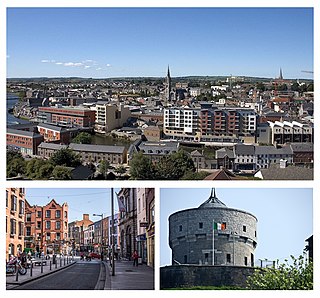
Drogheda is an industrial and port town in County Louth on the east coast of Ireland, 56 km (35 mi) north of Dublin. It is located on the Dublin–Belfast corridor on the east coast of Ireland, mostly in County Louth but with the south fringes of the town in County Meath, 49 km (30 mi) north of Dublin. Drogheda has a population of approximately 41,000 inhabitants (2016), making it the eleventh largest settlement by population in all of Ireland, and the largest town in the Republic of Ireland by both population and area. It is the last bridging point on the River Boyne before it enters the Irish Sea. The UNESCO World Heritage Site of Newgrange is located 8 km (5.0 mi) west of the town.

The River Boyne is a river in Leinster, Ireland, the course of which is about 112 kilometres (70 mi) long. It rises at Trinity Well, Newberry Hall, near Carbury, County Kildare, and flows towards the Northeast through County Meath to reach the Irish Sea between Mornington, County Meath, and Baltray, County Louth.
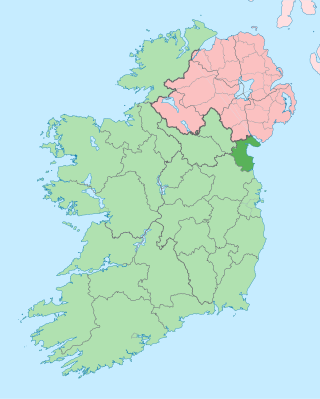
County Louth is a coastal county in the Eastern and Midland Region of Ireland, within the province of Leinster. Louth is bordered by the counties of Meath to the south, Monaghan to the west, Armagh to the north and Down to the north-east, across Carlingford Lough. It is the smallest county in Ireland by land area and the 17th most populous, with just over 139,100 residents as of 2022. The county is named after the village of Louth. Louth County Council is the local authority for the county.

The Mary McAleese Boyne Valley Bridge is a cable-stayed bridge in County Meath, and County Louth, Ireland. It spans the Boyne River 3 kilometres (1.9 mi) west of Drogheda on the county boundary between County Meath and County Louth and is part of the M1 Northern Motorway. When it opened in June 2003, it was the longest cable-stayed bridge in Ireland until 19 October 2009, when the River Suir Bridge opened on the N25.
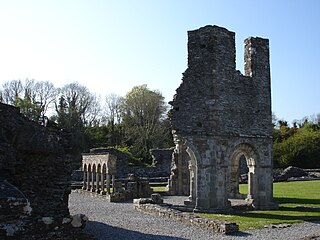
Mellifont Abbey, was a Cistercian abbey located close to Drogheda in County Louth, Ireland. It was the first abbey of the order to be built in Ireland. In 1152, it hosted the Synod of Kells-Mellifont. After its dissolution in 1539, the abbey became a private manor house. This saw the signing of the Treaty of Mellifont in 1603 and served as William of Orange's headquarters in 1690 during the Battle of the Boyne.

Brú na Bóinne or Boyne valley tombs, is an area in County Meath, Ireland, located in a bend of the River Boyne. It contains one of the world's most important prehistoric landscapes dating from the Neolithic period, including the large Megalithic passage graves of Knowth, Newgrange and Dowth as well as some 90 additional monuments. The archaeological culture associated with these sites is called the "Boyne culture".

Monknewtown, historically called Rathenskin, is a townland 3 km east of Slane in County Meath, Ireland. It stands on the right bank of the Mattock River, which feeds several historic watermills nearby and which forms approximately the townland's eastern boundary with Keerhan and Sheepgrange townlands in County Louth. Neighbouring townlands to the south are Balfeddock, Knowth, and Crewbane, to the west Cashel, Mooretown, and Knockmooney. The northern boundary of Monknewtown with Kellystown is formed by a tributary of the Mattock River, while the southern boundary is formed by the N51 road. Other than the latter, only minor roads traverse the townland, among them L5606 from west to east.
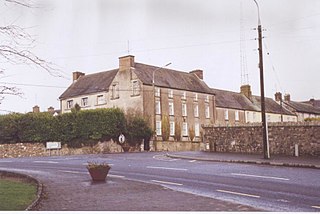
Collon is a village and townland in the south west corner of County Louth, Ireland, on the N2 national primary road. The village is home to the Cistercian Abbey of New Mellifont, and to Collon House, the ancestral home of the Foster family.
The Louth Senior Football Championship is an annual Gaelic Athletic Association competition organised by Louth GAA among the top Gaelic football clubs in County Louth, Ireland. The winning club qualifies to represent the county in the Leinster Senior Club Football Championship, the winner of which progresses to the All-Ireland Senior Club Football Championship.

Mornington is a coastal village on the estuary of the River Boyne in County Meath, Ireland approximately 5 km downriver from the centre of Drogheda. Together with the neighbouring villages of Laytown and Bettystown it comprises the census town of Laytown-Bettystown-Mornington, with a combined population of 10,889 at the 2011 Census and 11,872 at the 2016 Census. Mornington is part of the wider area collectively known as East Meath.
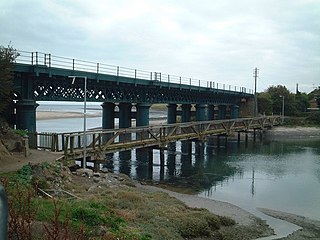
Laytown–Bettystown–Mornington–Donacarney is a built up area in East Meath, County Meath, Ireland, comprising the adjoining villages of Laytown, Bettystown, Mornington and Donacarney. Prior to 2016, it was listed as Laytown–Bettystown–Mornington.
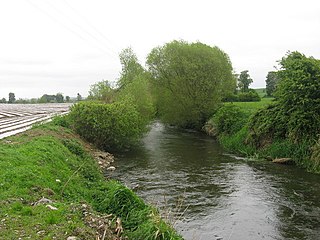
The River Glyde is a river in eastern Ireland, flowing from County Cavan to County Louth.

The River Dee is a river in eastern Ireland, flowing from County Cavan to flow into the River Glyde near the coast, in County Louth.

Boyne River is a stream in Northern Michigan, named for the River Boyne in Leinster, Ireland. Together with the north and south branches, the river system has approximately 22 miles (35 km) of mainstream and the water basin drains 40,320 acres (163.2 km2). Boyne River is Lake Charlevoix's second-largest tributary, after the Jordan River.
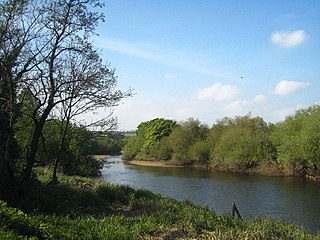
Oldbridge is a townland near Drogheda in County Meath, Ireland. The area is home to the Boyne Navigation, the Battle of the Boyne Interpretive Centre and the southern half of the Mary McAleese Boyne Valley Bridge.

Ferrard is a barony in County Louth, Ireland.
The Yellow River is a river in central Ireland, a tributary of the River Boyne.
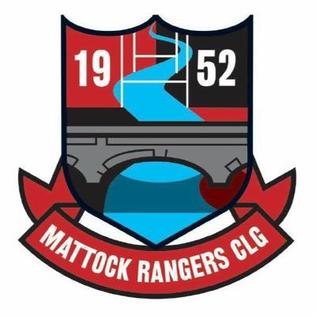
Mattock Rangers Gaelic Athletic Association is a Gaelic football, camogie, hurling and ladies' Gaelic football club based in Collon, County Louth, Republic of Ireland.[1][2][3][4]

















